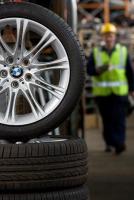Find parts for your car
Used Land Rover Discovery Differential
All used Land Rover Discovery Differential listed on Breakeryard.com are tested, original (OEM) manufacturer parts and come with a 14 day money back guarantee. Breakeryard.com list cheap new OES or aftermarket car parts at discounted prices or used OEM car parts up to 80% cheaper than main dealer prices for Land Rover Discovery from premium breaker yards from across the UK.
About Differential
What is a differential/what does it do?
A differential is a geared device that transfers power from the engine/gearbox to the driveshafts and on to the driven wheels of a car. The differential is generally located towards the centre of the driven axle. The internal gearing within the differential serves 3 main functions:
- Reduces the rotational speed of the gearbox or propshaft acting as a final down gearing mechanism
- Splits the gearbox output into multiple directions and directs it towards each driven wheel
- Allows each driven wheel to rotate at different speeds when cornering. This is essential as the outside wheel must travel further than the inside wheel when cornering.
Getting into the details of differentials
On a front wheel drive car the differential is generally located beside the gearbox and often offset from the centre of the axle.
A rear wheel drive car has its differential centred on the rear axle, with power transmitted from the gearbox via a propshaft.
All wheel drive cars have 2 or 3 differentials depending on the system. For permanent 4 wheel drive vehicles there is 1 for each axle and a 3rd central differential ensuring front and rear wheels can travel at different speeds. Non-permanent 4 wheel drive vehicles generally don’t have a central differential and front and rear wheels rotate at similar speeds.
There are various technologies employed in differentials but the most common types are open differentials, limited slip differentials, viscous coupling differentials, locking differentials and the Torsen differential. The type fitted to each vehicle is generally specified by the manufacturer and is not changed. However, some off road vehicles can be upgraded to offer better road or off road handling depending on the main use of the vehicle.
What if something goes wrong with a differential?
Due to the number of moving parts within a differential, routine maintenance is highly recommended. Issues are likely to occur if lubricant levels are not maintained. Symptoms of problems include gear/bearing whine or howling, clunking or clicking or other rumbling or whirring sounds emanating from the axle during driving.
Land Rover trivia
- Land Rover made the 101 Forward Vehicle for the UK military. It was originally built to haul howitzer cannons! The vehicle is so high, in fact, that a step had to be built into the front wheel so that the driver could get into the cab.
- Land Rover was the two-decade standout winner of the Camel Trophy, a gruelling off-road challenge that sees vehicles compete in Siberia, the Sahara, Australia, and other hostile terrains.
- Land Rover was notorious for trying to find ways to avoid paying taxes and extended that to their customers too. They built the Defender 110 so that it could (just about) fit 12 people! Technically, that meant that they could class it as a bus, and owners didn't have to pay standard road tax.
- The designer Charles S. King worked with Rolls Royce to design jet engines before going on to build the Range Rover. King would go onto building a car around those jet engines that then held the world land speed record, the first turbine-powered vehicle to do so.
- Inspired by the Jeeps that had been used in WWII, the first Land Rover's steering wheel was in the middle of the dashboard. This was partly to counter the need to create left and right-hand drive models for different countries.





